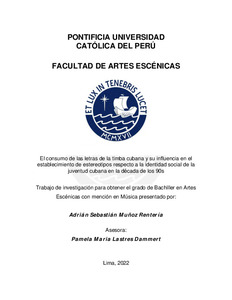| dc.contributor.advisor | Lastres Dammert, Pamela Maria | |
| dc.contributor.author | Muñoz Rentería, Adrián Sebastián | |
| dc.date.accessioned | 2023-09-05T19:42:59Z | |
| dc.date.available | 2023-09-05T19:42:59Z | |
| dc.date.created | 2022 | |
| dc.date.issued | 2023-09-05 | |
| dc.identifier.uri | http://hdl.handle.net/20.500.12404/25906 | |
| dc.description.abstract | La Timba es un género musical cubano que causó furor en la sociedad desde el momento en que
tocó los escenarios, pues cae en un momento de crisis cubana y, en medio de la represión por parte
del estado cubano, la timba surge no solo como canalizador o escape del arte de su nación, sino
como el reflejo del mensaje de la personalidad cubana. Por obvias razones, resulta mal vista para
las autoridades de la época, pues expresa tanto el mensaje del pueblo, como las maneras en la que
pretenden demostrarlo: mensajes de superación en la vida, quién toca la música más “sabrosa”;
una nueva faceta romántica, balanceándose entre el deseo, el amor, la misoginia, y la seducción,
provocando diversas respuestas tanto al oyente como al bailador, sin dejar de mencionar a los
críticos y a la población en general.
Es así como, en esta investigación, busco mostrar la manera en la que el consumo de las letras de
timba cubana influye en el establecimiento de estereotipos respecto a la identidad social de la
juventud cubana en la década de los 90, pues este intergénero permitió nuevos referentes de
identidad social que viabilizaron esta exuberante expresión artística como instrumento de denuncia
contra la dictadura cubana de la década de los ´90. Asimismo, se revisarán artículos de revistas,
libros y distintos trabajos de investigación de índole musicológica, además de entrevistas y
estudios de la industria musical, pues su importancia es debido a sus registros en una época tan
conflictiva y la presencia de otro tipo de investigación cuando se trata de la timba cubana, un
intergénero que llegó a convertirse en un fenómeno musical en todo el país. | es_ES |
| dc.description.abstract | Timba is a Cuban musical genre that caused a furor in society from the moment it hit the stages,
because it falls in a moment of Cuban crisis and, in the midst of repression by the Cuban state,
timba emerges not only as a channel or escape from the art of their nation, but as a reflection of
the message of the Cuban personality. For obvious reasons, it is frowned upon by the authorities
of the time, as it expresses both the message of the people and the ways in which they intend to
demonstrate it: messages of overcoming life, who plays the "tastiest" music; a new romantic facet,
swinging between desire, love, misogyny, and seduction, provoking diverse responses to both the
listener and the dancer, not to mention the critics and the population in general.
Thus, in this research, I seek to show the way in which the consumption of Cuban timba lyrics
influences the establishment of stereotypes regarding the social identity of Cuban youth in the
1990s, since this intergenre allowed new referents of social identity that made this exuberant
artistic expression viable as an instrument of denunciation against the Cuban dictatorship of the
1990s. Likewise, magazine articles, books and different research works of a musicological nature
will be reviewed, in addition to interviews and studies of the music industry, since its importance
is due to its records in such a conflictive period and the presence of another type of research when
it comes to Cuban timba, an intergenre that became a musical phenomenon throughout the country. | es_ES |
| dc.language.iso | spa | es_ES |
| dc.publisher | Pontificia Universidad Católica del Perú | es_ES |
| dc.rights | info:eu-repo/semantics/openAccess | es_ES |
| dc.rights.uri | http://creativecommons.org/licenses/by-sa/2.5/pe/ | * |
| dc.subject | Timba (Música)--Cuba | es_ES |
| dc.subject | Música popular--Cuba | es_ES |
| dc.subject | Identidad de grupo--Cuba | es_ES |
| dc.subject | Juventud--Aspectos sociales--Cuba | es_ES |
| dc.title | El consumo de las letras de la timba cubana y su influencia en el establecimiento de estereotipos respecto a la identidad social de la juventud cubana en la década de los 90s | es_ES |
| dc.type | info:eu-repo/semantics/bachelorThesis | es_ES |
| thesis.degree.name | Bachiller en Artes Escénicas con mención en Música | es_ES |
| thesis.degree.level | Bachillerato | es_ES |
| thesis.degree.grantor | Pontificia Universidad Católica del Perú. Facultad de Artes Escénicas | es_ES |
| thesis.degree.discipline | Artes Escénicas con mención en Música | es_ES |
| renati.advisor.dni | 09340768 | |
| renati.advisor.orcid | https://orcid.org/0000-0001-8221-2071 | es_ES |
| renati.author.dni | 73035438 | |
| renati.discipline | 215426 | es_ES |
| renati.level | https://purl.org/pe-repo/renati/level#bachiller | es_ES |
| renati.type | https://purl.org/pe-repo/renati/type#trabajoDeInvestigacion | es_ES |
| dc.publisher.country | PE | es_ES |
| dc.subject.ocde | https://purl.org/pe-repo/ocde/ford#6.04.04 | es_ES |






